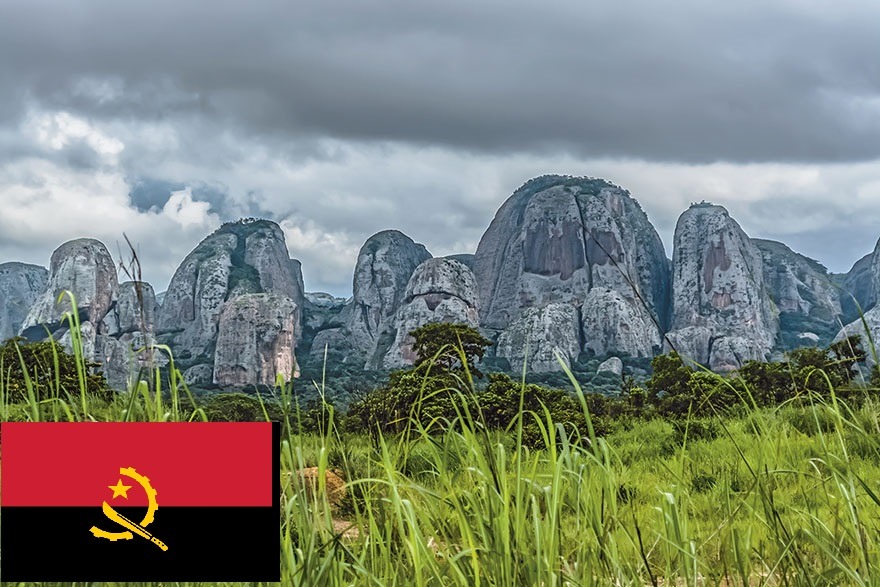General Country Information
- Official Name: Republic of Angola
- Capital City: Luanda
- Official Languages: Portuguese
- Currency: Kwanza (AOA)
- Government Type: Presidential Republic
Geographical Location:
- Continent: Africa
- Neighboring Countries: Namibia (south), Zambia (east), Democratic Republic of the Congo (north)
- Major Cities: Luanda, Huambo, Lobito, Lubango, Benguela
Brief History and Political Overview:
- Historical Background: Angola was a Portuguese colony from the 16th century until it gained independence in 1975.
- Significant Historical Events:
- 1975: Independence from Portugal.
- 1975-2002: Civil war between the MPLA (People’s Movement for the Liberation of Angola) and UNITA (National Union for the Total Independence of Angola).
- 2002: End of civil war, leading to relative stability.
- Government Type: Presidential republic with a multi-party system.
- Current Leaders: President João Lourenço (since 2017).
Religions and Cultural Highlights:
- Religions: Predominantly Christian (Roman Catholic and Protestant), with some indigenous beliefs.
- Cultural Highlights: Rich cultural heritage including traditional music (Semba), dance, and festivals like Carnival.
Economy
GDP:
- Latest Available Data: USD 61.918 billion (2023 estimate, World Bank)
Major Industries:
- Oil and gas
- Diamond mining
- Agriculture (coffee, sisal, corn, cotton, manioc, tobacco, and vegetables)
- Fisheries
- Manufacturing (mainly beverages, textiles, cement)
Key Economic Indicators:
- GDP Growth Rate: 0.9% (2023)- AFDB
- Inflation Rate: 13.6% in 2023 – AFDB
- Poverty Levels: Approximately 41% of the population living below the national poverty line (2022)
- Investment Climate: Improving, with significant foreign investments in oil and mining sectors.
Trade Statistics:
- Main Export Partners: China, India, United States, South Africa
- Main Import Partners: Portugal, China, United States, South Africa
- Major Goods Traded:
- Exports: Crude oil, diamonds, refined petroleum, natural gas, coffee
- Imports: Machinery, vehicles, food products, medicines
Currency and Exchange Rates:
- Exchange Rate: 1 USD ≈ 823 AOA (as of 2024)
Population
Total Population:
- Latest Available Data: Approximately 35 million (2023)
Population Growth Rate and Demographic Trends:
- Growth Rate: 3.3% (2023)
- Demographic Trends: High fertility rate, youthful population.
Age Distribution:
- 0-14 years: 47%
- 15-24 years: 19%
- 25-54 years: 28%
- 55-64 years: 4%
- 65+ years: 2%
Urban vs. Rural Population Distribution:
- Urban Population: 66%
- Rural Population: 34%
Major Ethnic Groups and Population Diversity:
- Major Ethnic Groups: Ovimbundu, Kimbundu, Bakongo, and various smaller groups.
- Population Diversity: Diverse ethnic groups with distinct languages and cultures.
Education Levels and Literacy Rates:
- Literacy Rate: 71.1% (2021)
- Education Levels: Primary education is compulsory; secondary and higher education are expanding.
Workforce
Labor Force Size and Composition:
- Total Labor Force: 15.223 million (2023 est.): number of people ages 15 or older who are employed or seeking work – (CIA Factbook)
- Composition by Sector:
- Agriculture: 50%
- Industry: 20%
- Services: 30%
Unemployment Rate:
- Rate: 14.62% (2023) – Statista
Workforce Skills and Education:
- Skills: Predominantly unskilled, with a growing number of skilled workers in urban areas.
- Education: Focus on improving vocational and technical training.
Labor Laws and Worker Rights:
- Laws: Comprehensive labor laws providing worker protections, minimum wage, and rights to unionize.
- Worker Rights: Enforced by the Ministry of Public Administration, Labor, and Social Security.
Migration Trends:
- Inward: Moderate, with some skilled foreign workers in oil and mining.
- Outward: Significant emigration to Portugal, Brazil, and other countries.
Natural Resources
Major Natural Resources:
- Oil
- Diamonds
- Iron ore
- Phosphates
- Copper
- Feldspar
- Gold
- Bauxite
- Uranium
Top Minerals (in order of economic importance):
- Oil
- Diamonds
- Iron ore
- Phosphates
- Copper
Annual Production Volumes for Key Minerals:
- Oil: Approximately 1.2 million barrels per day (2023)
- Diamonds: 9 million carats (2022)
- Iron ore: 3 million metric tons (2022)
- Phosphates: 1 million metric tons (2022)
- Copper: 50,000 metric tons (2022)
Mining and Natural Resources Laws and Regulations
Key Laws Governing Mining and Natural Resource Utilization:
- Petroleum Activities Law (Law No. 10/04): Regulates oil and gas sector. [https://www.fao.org/faolex/results/details/en/c/LEX-FAOC081903/]
- Mining Code (Law No. 31/11): Regulates all mining activities, including exploration and exploitation. [https://www.fao.org/faolex/results/details/en/c/LEX-FAOC119489/]
- Environmental Framework Law (Law No. 5/98): Ensures sustainable development and environmental protection.[https://www.fao.org/faolex/results/details/en/c/LEX-FAOC018069/]
Regulatory Bodies and Their Roles:
- Ministry of Mineral Resources and Petroleum: Oversees the oil, gas, and mining sectors.
- National Agency for Petroleum, Gas, and Biofuels (ANPG): Regulates petroleum industry activities.
- Institute for Geological and Mining Institute (IGEO): Regulates mining activities.
Recent Changes in Legislation:
- Angola – New Regulations on Local Content in the oil sector [https://investmentpolicy.unctad.org/investment-policy-monitor/measures/3601/angola-new-regulations-on-local-content-in-the-oil-sector]
- Mining 2024 – Angola – Chambers Global Practice Guides [https://practiceguides.chambers.com/practice-guides/mining-2024/angola]
Map of Angola:
Conclusion
Angola is a country rich in natural resources, with a significant portion of its economy driven by oil and diamond exports. Despite a history marked by colonialism and civil war, Angola has made strides towards political stability and economic growth. The youthful and rapidly growing population presents both challenges and opportunities for the country’s development.
Angola’s economy is diversifying, with efforts to improve the investment climate and infrastructure. Key sectors such as agriculture, manufacturing, and services are gradually expanding, though there is a need for enhanced education and vocational training to equip the workforce with necessary skills.
The government’s focus on sustainable development and regulatory reforms in the mining and petroleum sectors aim to attract foreign investments and ensure responsible resource utilization. Angola’s future hinges on balancing resource extraction with environmental protection, economic diversification, and social development, paving the way for a prosperous and stable nation.
References and Sources
- World Bank Angola Overview: https://www.worldbank.org/en/country/angola/overview
- World Bank Data on Angola: https://data.worldbank.org/country/angola
- CIA World Factbook Angola: https://www.cia.gov/the-world-factbook/countries/angola/
- African Development Bank Angola Profile: https://www.afdb.org/en/countries/southern-africa-region/angola
- National Institute of Statistics, Angola:http://www.ine.gov.ao/
- Ministry of Mineral Resources and Petroleum, Angola: https://mirempet.gov.ao/
- National Bank of Angola: https://www.bna.ao/
- United Nations Economic Commission for Africa: UNECA Angola Country Profile: https://www.uneca.org/eca-programmes/sro-ca/angola
- International Monetary Fund: IMF Angola Report: https://www.imf.org/en/Countries/AGO
